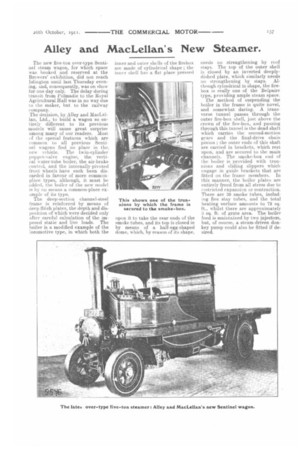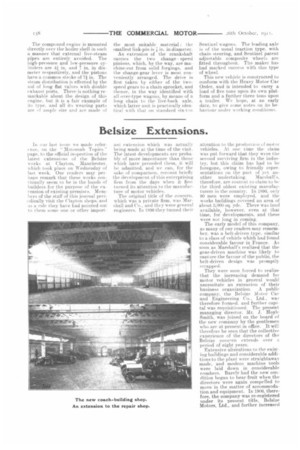Alley and MacLellan' s New Steamer.
Page 7

Page 8

If you've noticed an error in this article please click here to report it so we can fix it.
The new five-ton over-type Sentinel steam wagon, for which space was booked and reserved at the Brewers' exhibition, did not reach Islington until last Thursday evening, and, consequently, was on show for one day only. The delay during transit from Poimadie to the Royal Agricultural Hall was in no way due to ihe maker, but to the railway company.
The decision, by Alley and MacLellan, Ltd., to build a wagon so entirely different to its previous models will cause great surprise among many of our readers. Most of the special features which are common to all previous Sentinel wagons find no place in the, new vehicle. The twin-cylinder poppet-valve engine, the vertical water-tube boiler, the air-brake control, and the internally-pivoted front wheels have each been discarded in favour of more commonplace types, although, it must be added, the boiler of the new model is by no means a common-place example of its type.
The deep-section channel-steel frame is reinforced by means of deep flitch plates, the depth and disposition of which were decided only after careful calculation of the imposed static and live loads. The boiler is a modified example of the locomotive type, in which both the inner and outer shells of the firebox are made of cylindrical shape ; the inner shell has a fist place pressed upon it to take the rear ends of the smoke tubes, and its top is closed in by means of a half-egg-shaped dome, which, by reason of its shape, needs no strengthening by roof stays. The top of the outer shell is closed by an inverted deeplydished plate, which similarly needs no strengthening by stays. Although cylindrical in shape, the firebox is really one of the Belpaire type, providing ample steam space. The method of suspending the boiler in the frame is quite novel, and somewhat daring. A transverse tunnel passes through the outer fire-box shell, just above the crown of the fire-box, and passing through this tunnel is the dead shaft which carries the second-motion gears and the final-drive chain pinion ; the outer ends of this shaft are carried in brackets, which rest upon, and are secured to the main channels. The smoke-box end of the boiler is provided with trunnions and sliding slippers which engage in guide brackets that are fitted on the frame members. In this manner, the boiler plates are entirely freed from all stress due to rastrie.ted expansion or contraction. There are 39 smoke tubes, including five stay tubes, and the total heating surface amounts to 72 sq. ft., whilst there are approximately 3 sq. ft. of grate area. The boiler feed is maintained by two injectors, but, of course, a steam-driven donkey pump could also be fitted if desired. The compound engine is mounted directly over, the boiler shell in such a manner that external live-steam pipes are entirely avoided. The high-pressure and low-pressure cylinders are 4.-jin. and 7 in. in diameter respectively, and the pistons have a common stroke of 71 in. The steam distribution is effected by the aid of long flat valves with double exhaust ports. Them is nothing remarkable about the design of this engine. but it is a fair example of its type. and all its wearing parts are of ample size and are made of
the most suitable material ; the smallest link-pin is in. in diameter. An extension of the crankshaft carries the two change speed pinions, which, by the way, are machine-cut from solid forgings. and the change-gear lever is most, conveniently arranged. The drive is first taken by either of the twospeed gears to a chain sprocket, and thence, in the way identified with all over-type wagons, by means of a long chain to the live-hack axle, which latter unit, is practically identical with that on standard six-ten Sentinel wagons. The leading axle is of the usual traction type, with chain steering, and Sentinel patent adjustable composite wheels are fitted throughout. The maker has had marked success with this type of wheel.
This new vehicle is constructed to conform with the Heavy Motor Car Order, and is intended to carry a load of five tons upon its own platform and a further three tons upon a trailer. We hope, at an early date, to give some notes on its behaviour under working conditions.






















